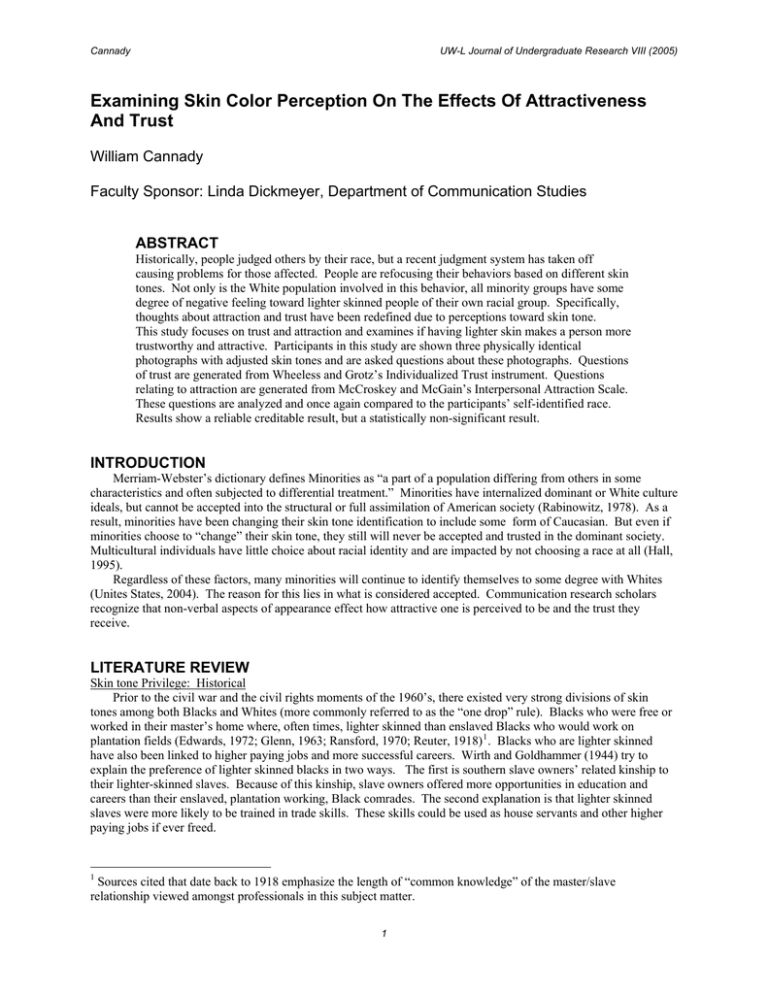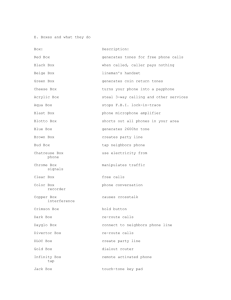Examining Skin Color Perception On The Effects Of Attractiveness And Trust
advertisement

Cannady UW-L Journal of Undergraduate Research VIII (2005) Examining Skin Color Perception On The Effects Of Attractiveness And Trust William Cannady Faculty Sponsor: Linda Dickmeyer, Department of Communication Studies ABSTRACT Historically, people judged others by their race, but a recent judgment system has taken off causing problems for those affected. People are refocusing their behaviors based on different skin tones. Not only is the White population involved in this behavior, all minority groups have some degree of negative feeling toward lighter skinned people of their own racial group. Specifically, thoughts about attraction and trust have been redefined due to perceptions toward skin tone. This study focuses on trust and attraction and examines if having lighter skin makes a person more trustworthy and attractive. Participants in this study are shown three physically identical photographs with adjusted skin tones and are asked questions about these photographs. Questions of trust are generated from Wheeless and Grotz’s Individualized Trust instrument. Questions relating to attraction are generated from McCroskey and McGain’s Interpersonal Attraction Scale. These questions are analyzed and once again compared to the participants’ self-identified race. Results show a reliable creditable result, but a statistically non-significant result. INTRODUCTION Merriam-Webster’s dictionary defines Minorities as “a part of a population differing from others in some characteristics and often subjected to differential treatment.” Minorities have internalized dominant or White culture ideals, but cannot be accepted into the structural or full assimilation of American society (Rabinowitz, 1978). As a result, minorities have been changing their skin tone identification to include some form of Caucasian. But even if minorities choose to “change” their skin tone, they still will never be accepted and trusted in the dominant society. Multicultural individuals have little choice about racial identity and are impacted by not choosing a race at all (Hall, 1995). Regardless of these factors, many minorities will continue to identify themselves to some degree with Whites (Unites States, 2004). The reason for this lies in what is considered accepted. Communication research scholars recognize that non-verbal aspects of appearance effect how attractive one is perceived to be and the trust they receive. LITERATURE REVIEW Skin tone Privilege: Historical Prior to the civil war and the civil rights moments of the 1960’s, there existed very strong divisions of skin tones among both Blacks and Whites (more commonly referred to as the “one drop” rule). Blacks who were free or worked in their master’s home where, often times, lighter skinned than enslaved Blacks who would work on plantation fields (Edwards, 1972; Glenn, 1963; Ransford, 1970; Reuter, 1918) 1 . Blacks who are lighter skinned have also been linked to higher paying jobs and more successful careers. Wirth and Goldhammer (1944) try to explain the preference of lighter skinned blacks in two ways. The first is southern slave owners’ related kinship to their lighter-skinned slaves. Because of this kinship, slave owners offered more opportunities in education and careers than their enslaved, plantation working, Black comrades. The second explanation is that lighter skinned slaves were more likely to be trained in trade skills. These skills could be used as house servants and other higher paying jobs if ever freed. 1 Sources cited that date back to 1918 emphasize the length of “common knowledge” of the master/slave relationship viewed amongst professionals in this subject matter. 1 Cannady UW-L Journal of Undergraduate Research VIII (2005) Skin tone privilege: Currently Realizing the “full circle” characteristics of color preferences, researchers have revisited the subject to see if there is still a want to be associated with lighter skin among people of color. Ronald Hall (2004) reexamined the why factor; what makes Blacks want to become associated with lighter skinned people and what effect does this have on the Black population in general? Hall’s qualitative study found distinctive themes that make Blacks want to become associated with lighter skinned people. Several current studies have concluded that being lighter skinned is a symbol of status and prestige (i.e. Keith & Herring, 1991; Ross, 1997; Keenan, 1996, Hall, 2004). Hall’s study also concluded that being a darker skin has a negative connotation in both Black and White communities. Keenan (1996) tried to explain the why factor in a quantitative way. He used a range of colors found in magazine advertisements and ranked the occurrences of each color. He concluded the occurrence of lighter skinned models in magazines has become increasingly frequent. He also noted the influence of these images often reinforces the standards of “pretty” and “beautiful.” If having lighter skin is scattered throughout many magazines and people respond to this as a standard of beauty, the reason many people affiliate lighter skin with beauty and status is to be expected. Ross (1997) examined mate selection among Black college students. Ross’ results concluded that makes of lighter skin tones were a preference to these Black students. In addition, Ross concluded the media reinforces both ideal model for beauty and status, therefore, creating a self-fulfilling prophecy in regards to skin tone (preestablished though saying lighter skin is more beautiful; the media reinforces this though process, therefore, creating the standards of beauty and relating this standard to lighter skin). Studies have shown that having a lighter skin holds a certain amount of privilege, which is one reason why people want to become lighter skinned. Another possible benefit seen is someone with lighter skin has an increased in the trust they receive (Andsager & Mastin, 2003). Andsager and Mastin’s study tried to explain the link between race and credibility of political news writers. Their study concluded interpersonal contact does not affect perceptions of source credibility (readers from a racially homogeneous region will have less credibility about multicultural issues). The study also concluded, overall, there is no difference in perceived columnist credibility among so-called communities of race. Racial Identity With emphasis on skin tones, it can be confusing as to what is considered Black, White and what lies inbetween. Rockquemore and Brunsma (2002) placed the color people used to identify themselves into four categories—singular identity, boarder identity, protean identity, and transcendent identity. People who happen to fall into the category of group singularity reference themselves to only one race. Protean members choose their racial affiliation based on different moments that occur throughout their day. Transcendent members do not identify with a specific race at all. The study concluded more people identify with broader identity and choose “biracial” as a completely independent race. This fact is important to note as several studies only focus on what is distinctly Black and what is distinctly White. Using Rockquemore and Brunsma’s (2002) study to choose participants for other studies, one would have to include members who identify themselves as biracial or create a whole different grouping of these people for proper analysis. SUMMARY There were several variables that could improve the study conducted by Andsager & Mastin (2003). The first and most influential are the location and region of the study. The two universities used in the study involved a history of racial tension and friction that influenced the study. Studies conducted that are impartial to location achieve the best results when discussing skin tones and race relations (Andsager & Mastin, 2003). The study makes a distinct division of the two and because of other studies, explains the many faces of race and color among the African American community. RESEARCH QUESTIONS Because the dominant culture may hold lighter skin tone as attractive and influence cultural norms for attraction, it is valuable to research the attitudes toward skin tone and attractiveness among a broad range of subjects. Therefore, the following hypothesis are proposed: H1 Photos of persons with lighter skin tones will receive higher scores for perceived attraction among a diverse sample of participants. 2 Cannady UW-L Journal of Undergraduate Research VIII (2005) H2 Photos of persons with darker skin tones will receive lower scores for perceived trust among a diverse sample of participants. DEFINITIONS Several racial and ethnic studies scholars have agreed upon definitions for studies in racial and ethnic studies. Operational Definitions Skin tone will be defined in the same manner as Keenan did in his study. Taking standards from the printing industry, categories will be established based on print color tones used for paper printing. Race in this study will be determined by demographic information by the survey participants. Participants of color will be identified by indicating their race as non-White/Caucasian. Those who identify themselves as White/Caucasian will be classified in the same racial group. METHOD Measurements This research is descriptive in nature. Descriptive research involves asking the status of participants and examining their behaviors (Bergman, 2004). In this case, the independent variable, skin tone, will serve as a predictor for the dependant variables of attraction and trust behaviors. Procedure Specifically, the research will be based on survey design. A photo of one person will be adjusted to three different levels of darkness in their skin tone via computer software (Adobe Photoshop). Participants will be asked the same set of questions for the three different pictures. The order of the photographs shown will be most dark skin tone, normal tone, and finally lighter tone. By conducting research in this method instead of displaying several different people, physical fetishes cannot be a factor of criticizm in the final results. Surveying trust will involve using a standardized scale that has been used in the past for several stuides, but few (if any) for a racial/ethnic/color study. Trust will be measured using scales from the Individualized Trust Scale (ITS) developed by Wheeless and Grotz (Wheeless & Grotz, 1977). Participants will be asked to rate the photo on a five-point scale based on levels of the following: trustworthy and untrustworthy, candid to deceptive, and honest to dishonest. In order to measure levels of attraction, McCroskey and McGain’s Interpersonal Attraction Scale will be used. This scale addresses physical, social, and task oriented attraction questions. Participants will be using the provided three photographs to relate and answer these questions. As far as where to conduct this research, the key lies in getting out and being available to diverse populations. Survey areas will occur in Minneapolis, MN and La Crosse, WI. Each city, also, has very prominent tourist areas where people from all over the US visit. In order to get a wider range of the country without leaving the city, tourist grounds and residential areas become key in gathering diverse participants. Subjects Several past studies that have been conducted in the sociology field have limited their subjects to Black students who attend historically Black universities. It becomes extremely difficult to devise an acceptable answer for race relations if the subjects surveyed do not communicate on a diverse level daily. Surveying at historically Black universities ask students questions about different races or skin tones to people who do not deal with these people daily. In order for a study to be accurate, all subjects need to be adjusted before focusing research on specific instances (in this case, historically Black university students). Therefore, surveys were given to 149 people of all ages, all colors, and all sexes. Subject’s age ranged from 19-65 years old. In studies dealing with race issues, diversity can be seen as a limitation. This holds true for this study, however, the number of people of color in this study is slightly below 40 percent. Data collection occurred in Minneapolis, MN and La Crosse, WI. Measures There are some independent and dependent variables that needed to be taken into account in this research— most coming from demographic questions at the end of the survey. To define a “diverse group of participants”, Subjects who indicated their race as “White” or “Caucasian” are put into one racial group while all other answers are grouped into another racial group. White or Caucasian was coded as “1” for SPSS entry while all other racial groups were coded as “2”. Dependant variables (based of participants’ answers of photographs) were also coded into the SPSS data entry program. 3 Cannady UW-L Journal of Undergraduate Research VIII (2005) Procedure Data collection was non-random using an unofficial quota of participants. Because diversity of key to a successful study, targeting people of color was key to ensuring a less bias result. DATA ANALYSIS Data was entered into an ANOVA test and the mean values of the three photographs were examined. All answers of trust and attractiveness will be compared to the “skin color” of the participants. “Skin colors” will be any color identification that is not described by survey participants as “White” or “Caucasian.” By analyzing data in this method, all commonly thought minority participants will be compared to White or Caucasian participants. What is being examined is a significant difference between mean values of the three photographs in comparison to participants identified race or skin tone. Because three pictures were used and the survey was administered three different times, each photograph’s survey needs to have its reliability checked. Also, because two different surveys were used, one for attraction and the other for trust, these values of reliability need to be checked also for each photograph and its corresponding survey. RESULTS Addressing H1, attraction reliability values were .88 for the darkest photo’s survey segment, .90 for the regular photo’s survey segment, and .89 for the lightest photo’s survey segment. These three values fall within the accepted values of reliable data and, therefore, the results are valid with addressing attraction (H1). Addressing H2, trust reliability values were .89 for the darkest photo’s survey segment, .89 for the regular photo’s survey segment, and .93 for the lightest photo’s survey segment. These three values fall within the accepted values of reliable data and, therefore, the results are valid with addressing trust (H2). The first hypothesis was looking for an increase of attraction with the photograph of lighter color. Though past studies have shown this to be true, this study does not have significant enough values to make this claim. For all three photo’s surveys, the data is non-significant for this hypothesis. The second hypothesis was looking for an increase of trust with the photograph of lighter skin color. Though past studies have shown this to be true, this study does not have significant enough values to make this claim. For all three photo’s surveys, the data is non-significant for this hypothesis. DISCUSSION Though other studies that have dealt with this topic matter have shown a preference in people who have lighter skin tones, this study did not show the same case. This may be for several limiting reasons. The researcher was only able to travel locally in a typically seemingly racially tolerant part of the country. It would be very interesting to see if the same result holds true for a wider geographical area (specifically, the deep south United States). One other limiting factor that may have been the age of the participants. Most of the participants were between the ages of 20-30 years old. It would be interesting to see if the same result holds true with people between the ages of 40-70 years old. Although the participants of color were slightly under 40%, more people of color are needed in order to achieve a more credible result. If data analysis was conducted on the basis of analyzing each participant defined race as “a diverse set of participants”, there was a significant enough different of surveys dealing with attraction, but still a non-significant change for trust. Even though interesting for future study, data was still too few for specific people of color to form a credible conclusion. One other interesting limitation with this study was the participants lack of integrity. While some surveys were issued on a personal one-to-one basis, the bulk of the participants were issued the survey in a mass setting (such as a lecture hall, general auditorium, park or other large gathering area). This made the proctoring of the survey difficult (if not impossible), and participants took advantage of this fact. The survey was issued as a packet—all three surveys were stapled together. After completing the first survey and showing the participants the second picture—which in fact was a color adjusted replica of the first picture—participants would page back to the first survey and copy their answers from this survey onto the second and third surveys issued. This is a perplexing event as the study never focused on the subject of race, but rather the subject of skin tone and colorization. 4 Cannady UW-L Journal of Undergraduate Research VIII (2005) Interestingly, participants concluded that a study which analysis skin tone at any rate is a study in race—which is not the case. CONCLUSION Because of the acceptable value of reliability of the study but statistically insignificant result, any conclusions that can be drawn from this study are purely speculative and open for heated debate. One conclusion, however, can be made about those who participate in such studies; when asking questions that deal with skin tone, the vast majority of public directly associate skin color with a predefined racial group. Because of this irrational link, people seemingly have the almost intrinsic reaction to answer in the most positive—not neutral—method possible in order to fulfill some unknown disposition. Future endeavors will involve a wider geographic area and a greater degree of diversity. Future endeavors also will also mimic the study’s method, but assign several teams to carry out the research. Each team would have a person of a different race as a leader (i.e. a team lead by an American Indian, White, Black or someone of Arabian decent) and compare those results. This study suffered from the fact that the researcher is not White; this could easily influence peoples’ answers when presenting a survey they think is race related when it is, in fact, not. REFERENCES Ayalon, L, & Young M. (2003). A comparison of depressive symptoms in African Americans and Caucasian Americans (2003). Journal of Cross-Cultural Psychology, 34(1). Andsager, J. L. & Mastin, T (2003). Racial and regional differences in readers’ evaluations of the credibility of political columnists by race and sex. Journalism & Mass Communication Quarterly. 80(1), 52-72. Bergman, B. (3/24/04). Online: http://www.campbell.edu/faculty/bergemann/res14.html DeVito, J. (2004). The interpersonal communication book. Boston: Allyn and Bacon. Edwards, O L. (1972). Skin color as a variable in racial attitudes of black urbanites. Journal of Black Studies. 3, 473-483. Glenn, N. D. (1963). Negro prestige criteria: a case study in the bases of prestige. American Journal of Sociology. 68,645-657. Hall, R. (1995). The bleaching syndrome: African Americans’ response to cultural domination vis-à-vis skin color. Journal of Black Studies. 26(2), 172-184. Keenan, K. (1996). Skin tones and physical features of blacks in magazine advertisements. Journal of Mass Communication Quarterly, 73(4). Keith, V. M., Herring, C. (1991). Skin tone and stratification in the Black community. American Journal of Sociology. 97(3), 760-778. Rabinowitz, H. (1978). Race relationships in the urban South. New York: Oxford University Press. Ransford, E. (1970). Skin color, life chances and anti-white attitudes. Socail Problems. 18, 164.178. Reuter, E. (1969). The mulatto in the United States. New York: Haskell House. Richmond, P., McCroskey, J. (2000). Nonverbal behavior in interpersonal relationships. Boston: Allyn and Bacon. Rockquemore, K. A., Brunsma, D. L. (2002). Socially embedded identities: Theories, typologies, and processes of racial identity among Black/White biracials. The sociological Quarterly, 43(3), 335-355. United States 2000 Census (3/22/04). UQuestions and Answers for Census 2000 Data on Race. Online: http://www.census.gov/Press-Release/www/2001/raceqandas.html. Vontress, C. (1970). Counseling Black. Personnel and Guidance Journal, 48, 713-719. Wheeless, L., & Grotz, J. (1977). The measurement of trust and its relationship to self-disclosure. Human Communication Research, 3, 250-257. 5





